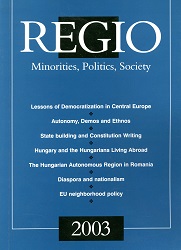The Creation of the Hungarian Autonomous Region in Romania (1952): Premises and Consequences
The Creation of the Hungarian Autonomous Region in Romania (1952): Premises and Consequences
Author(s): Stefano BottoniSubject(s): History
Published by: MTA Társadalomtudományi Kutatóközpont Kisebbsegkutató Intézet
Keywords: autonomy; communism; Romania; Hungarians
Summary/Abstract: The study focuses on an interesting and still unexplored case of nationality policy in communist Eastern Europe: the Hungarian Autonomous Region in Romania. The creation of this region, along with the Yugoslav experiment, was the only example of integrative minority policy in the post-war Eastern Europe, and represented the attempt to solve a deeply rooted national question by giving administrative “autonomy” to Szeklerland, the predominantly Hungarian region of Transylvania. The collective memory of Hungarians living in the HAR preserves the years following its establishment as a period of cultural development, however paradoxical it may seem when taking into account the high level of ideological pressure, the massive political reprisals and the extremely low standard of living suffered by most of the population in the first decade of the communist regime.
Journal: Regio - Minorities, Politics, Society - English Edition
- Issue Year: VI/2003
- Issue No: 1
- Page Range: 71-94
- Page Count: 24
- Language: English

